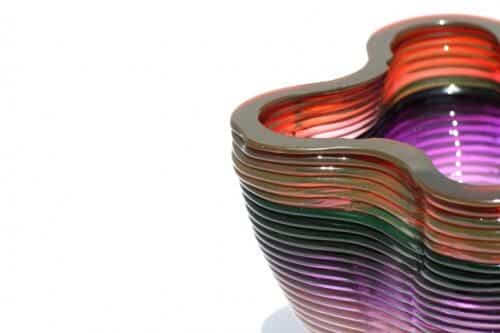
By: Yael Halfman Cohen
Nature offers a pool of economical, efficient, elegant and sustainable design solutions, but various limitations - technologies and production - still constitute barriers to design and production "exactly" as in nature.
At the Media Lab at MIT, Neri Oxman and her team, in collaboration with the Glass Lab and the Wyss Institute at Harvard University, recently presented a 3D printer for glass, which may in the future allow us to get a little closer to the level of complexity of the structural solutions in nature. The machine, the first of its kind, heats the glass to more than 1,000 degrees Celsius in an oven, then shapes it in a process of extrusion by passing it through an aluminum tube. The viscous, semi-transparent substance drips until it hardens, in a rib-like structure. At this stage, we are talking about proof of feasibility. The products are still small, and limited to a length of 25 cm and a height of 28 cm, but on the other hand, they demonstrate the optical properties, the quality, and the structural strength of this printing technology.
If we return to nature for a moment, we will realize that the purpose of this new creation technology is much greater, literally. Oxman believes that printing with this technology will in the future make it possible to produce much more dynamic facades for buildings, and perhaps even answer many important questions in the world of architecture:
- Can we produce glass structures with internal channels for ventilation and water circulation?
Can we transcend the tradition of isolating functions into separate parts, and combine them all in a single structural envelope?
One of the prominent advantages of XNUMXD glass printing over traditional glass production is the ability to produce an inner surface as complex as the outer. In blown glass, the inside is smooth. In printing technology, the shape and texture of the object are controllable, up to a high level of resolution.
One can sail in the imagination and see the consequences for the world of architecture. A structure with one facade that has several functions, controlling the flow of light, using the glass channels to transfer water, biological material and even information, if optical fibers are used.
In another Oxman project, Wanderers, a dynamic system with a flow envelope was already designed. Oxman and her team created wearable skin using microfluidic tubes that allow organic material such as photosynthetic bacteria to flow through the clothing.
Theoretically, assuming that the size limit will be solved (the challenge in the work process), XNUMXD printing machines will be able to produce a facade that responds to the environment in a similar way to clothing for buildings as well. Transparency of such a facade through glass printing, you can help design the response to the environment.
Right now the future sounds confusing and vague, and one can only speculate how such glass printing technology could enable biomimetic innovation in the world of architecture, but it is clear that this is another step, bringing us closer to producing and designing buildings like in nature.
